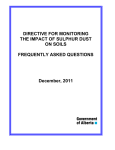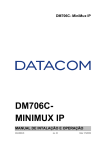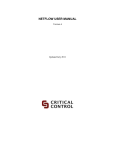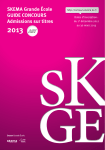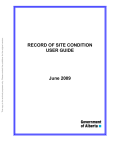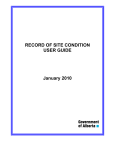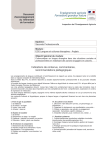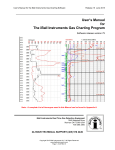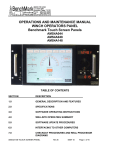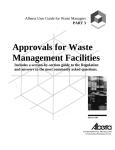Download User Guide for Record of Site Condition
Transcript
RSC Frequently Asked Questions RECORD OF SITE CONDITION FREQUENTLY ASKED QUESTIONS December, 2012 RSC Frequently Asked Questions ISBN: 978-1-4601-0070-7 (Printed version) ISBN: 978-1-4601-0071-4 (On-line version) Web Site: http://environment.gov.ab.ca/info/ Record of Site Condition – Frequently Asked Questions December, 2012 Alberta Environment and Sustainable Resource Development Any comments, questions or suggestions regarding the content of this document may be directed to: Air, Land and Waste Policy Branch, Policy Division Alberta Environment and Sustainable Resource Development 10th Floor, Oxbridge Place 9820 – 106 Street NW Edmonton, Alberta T5K 2J6 Fax: (780) 422-4192 Email: [email protected] Additional copies of this document may be obtained by contacting: Information Centre Alberta Environment and Sustainable Resource Development 4th Floor, Twin Atria Building 4999–98 Avenue Edmonton, Alberta, T6B 2X3 Phone: (780)-427-2700 Fax: (780)-422-4086 Email: [email protected] December 2012 i RSC Frequently Asked Questions INTRODUCTION Purpose of Record of Site Condition – Frequently Asked Questions In April 2009, Alberta Environment released the revised Record of Site Condition form (RSC). The RSC must accompany all Phase 2 environmental site assessment (ESA) reports, remediation reports, and risk management plans submitted to the Department. This Record of Site Condition – Frequently Asked Questions (RSC-FAQ) document serves as a companion document for the Record of Site Condition User Guide (2012) and the Record of Site Condition (2009). The RSC-FAQ is developed to address frequently asked questions received by Alberta Environment and Sustainable Resource Development. It is intended to be a living document, and may be periodically updated or amended. For further information, or in the event of discrepancy, refer to Alberta Tier 1 Soil and Groundwater Remediation Guidelines (2007a, as amended), Alberta Tier 2 Soil and Groundwater Remediation Guidelines (2007b, as amended), and the Record of Site Condition User Guide (2012). December 2012 Page 1 of 8 RSC Frequently Asked Questions GENERAL QUESTIONS 1. Do I have to submit a Record of Site Condition (RSC) to Alberta Environment and Sustainable Resource Development? Yes. Any Phase 2 environmental site assessment (ESA) report, remediation report, confirmatory data report, or risk management plan required by the Department must be submitted with a completed Record of Site Condition. 2. What happens if a Phase 2 ESA is submitted without an RSC? A Phase 2 ESA submitted without an RSC will be refused as incomplete. Reports for approved facilities without an RSC will be deemed administratively incomplete. 3. Do Phase 1 ESA reports need an RSC? What if there is a probability of contamination? No. Phase 1 ESA reports do not require an RSC. An RSC would be submitted with the subsequent Phase 2 ESA following sampling, delineation and/or remediation of soil and groundwater at a site. 4. If a report is dated prior to May 1, 2008 but submitted to the Department after that date, is an RSC required? Yes. The requirement to submit an RSC is based upon the report submission date, not the date of the report or when the ESA work was done. ALL Phase 2 ESA reports and risk management plans submitted to the Department after May 1, 2008 require an RSC. 5. If a release occurred after the 2009 RSC version was released on April 6, 2009, do I have to submit the RSC by June 30, 2009? No. Please submit the RSC when the Phase 2 ESA report is submitted. The June 30, 2009 date only applies to reports previously submitted between May 1, 2008 and April 06, 2009 without an RSC. 6. Have Alberta Environment and Sustainable Resource Development’s release reporting requirements changed? No. Only the requirement to submit the RSC as part of the ESA has changed. Continue to submit Phase 2 ESA reports, risk management plans as in the past. 7. How do I complete the RSC form for a site with elevated, natural concentrations of the assessed compounds? If the natural concentration of a COPC, in the absence of any input from anthropogenic sources or activities, exceeds the generic values of the Alberta Tier 1 guidelines, the natural background concentration may be used as a Tier 1 assessment endpoint. The licensed operator or its authorized agent must provide justification to the Department to demonstrate that the abnormal background condition was properly assessed. If this applies to the COPC, question 6.2.3 of the RSC can be answered “no”. The exceedance over the generic values of Alberta Tier 1 guidelines should be highlighted in the tables of the analytical results of the ESA report to facilitate report December 2012 Page 2 of 8 RSC Frequently Asked Questions review. For more information see the Alberta Tier 1 Soil and Groundwater Remediation Guidelines (AENV, 2007a, as amended). 8. How do I complete the RSC for a site with elevated, naturally occurring salinity? Follow the foregoing approaches provided under Question #7. 9. Can I submit an RSC electronically? Is there an on-line electronic version of the RSC? Yes. You should submit an RSC together with the ESA report electronically by email. Alberta Environment and Sustainable Resource Development is working to develop a web-version of the RSC form that may be completed and submitted electronically on-line in the future. December 2012 Page 3 of 8 RSC Frequently Asked Questions QUESTIONS ABOUT THE RSC FORM 10. What/who is a landowner? Does a long-term lessee count as a landowner? The landowner of a property is the owner(s) registered on the land title. A lessee is not a landowner. 11. What/who is an occupant? An occupant is a person who resides on a site, except for agricultural sites. For agricultural sites, an occupant includes someone who may only access the site occasionally for an agricultural operation. 12. What is the AENV file number? The Development issues file numbers for some types of site activities. Sometimes, these numbers may change due to a change in site operation. In that case, use the most recent file number issued by the Department. The recent name change of the Department does not affect the numbering system. 13. Where do I get an AENV file number? An Alberta Environment and Sustainable Resource Development file number will be assigned by a staff member of the Department upon the initial correspondence or first written submission regarding a site activity. If there has not been previous correspondence with the Department on a site activity, or an Alberta Environment and Sustainable Resource Development file number does not appear on correspondence, leave this box blank. 14. How do I answer question 6.2.2 on the RSC if a Phase 2 ESA is conducted to assess a drilling waste disposal area but the disposal area is not found? If the Assessing Drilling Waste Disposal Areas checklists or calculations require a Phase 2 ESA for the drilling waste disposal area, then a reasonable effort must be made to locate and sample the disposal area. If it cannot be found, then answer “no” to question 6.2.2. 15. Is an RSC required for the Compliance Option 1 or Compliance Option 2 checklists in Assessing Drilling Waste Disposal Areas: Compliance Options for Reclamation Certification? Compliance Options 1 and 2 are Phase 1 ESAs, and do not require an RSC. If a drilling waste disposal area is assessed under Compliance Option 3, it requires an RSC. 16. In Section 6.3.1, can I select “other” if there is guideline exceedance that may be professionally justified as minor, or abnormal background concentration? Prior to exercising this option, any possible justifications for guideline exceedance must be approved by the Department. Then, you may select “Other” to justify guideline exceedance that may be deemed as minor or abnormal baseline, when exercising professional judgment. List this reason as well as the substances this applies to in the space provided. December 2012 Page 4 of 8 RSC Frequently Asked Questions 17. If there are no contaminated areas (e.g. answer to section 6.3.4 is “none”), is it still necessary to complete sections 6.3.5, 6.3.6, 6.3.10, 6.3.11, and 6.3.12? Yes, complete the rest of Section 6.3. 18. How should the required summary tables for the contaminants of potential concern on page 6 of the RSC be completed? Will the Department accept any format? The summary tables may follow the format of the example tables found in the Appendix of the updated RSC User Guide. The Department will accept alternative formats too, provided that the information included in summary tables is displayed in units and measurements found in the Alberta Tier 1 guidelines. 19. Is professional sign-off required for the RSC? No, professional sign-off is not required, but the operator or their authorized representative must sign the Declaration in section 8. 20. Who can sign the RSC? Who is an authorized representative? Can a consultant sign the RSC? The person who signs the RSC must understand the information contained in the form. An operator can authorize their consultant or another person familiar with the information in the RSC to sign. December 2012 Page 5 of 8 RSC Frequently Asked Questions QUESTIONS ABOUT REPORTING 21. Is an RSC form required for emergency release assessments such as 7-day reports? A release that results in the requirement to submit a 7-day report will require an RSC when the Phase 2 ESA is submitted to the Department. 22. Regarding section 6.3.7, what if an operator has taken over a site and is unaware if a spill was reported in the past? Is the spill still reportable? To whom should I report, Alberta Environment and Sustainable Resource Development, or Energy Resources Conservation Board (ERCB)? Does a Phase 2 ESA report count as a report? Some spills or releases are not known until they are exposed by other work on the site. However, they should be reported upon discovery. If no contamination is left at the site following assessment or remediation, there is no need to answer section 6.3.7. If there is still contamination remaining and this is the first report to Alberta Environment and Sustainable Resource Development, check “no” even if you are not the original operator of the site at the time of the spill. For Upstream Oil and Gas sites that are not operating under approval or code of practice with Alberta Environment and Sustainable Resource Development, most common releases are reportable to an agency other than the Department. Where you are not the original operator of the facility and there is no historical information regarding the substance release, it may be difficult to determine reporting requirements based on a Phase 2 ESA. In the instance where it is not clear whether the information was reported, historical information is lacking but spills resulting from the activity would have been typically reported to an agency other than the Department, check “not applicable” for section 6.3.7. 23. If a tank pull was completed and no contamination was found, does a report or RSC need to be submitted? No, an RSC only needs to be submitted if a Phase 2 ESA was conducted. 24. During the Phase 2 ESA we collected samples for soil, surface water, and ground water. Should I attach all summary tables for the samples collected or only select ones? Please attach summary information for all samples taken at the site. This provides a more thorough summary of the site information. 25. Do soil monitoring reports for Approved Facilities require an RSC? Yes, soil monitoring reports require an RSC for the area(s) being monitored in the current report. Areas that were monitored in previous years should not be included in the RSC, only information from the current report is required. December 2012 Page 6 of 8 RSC Frequently Asked Questions 26. Do soil management reports for Approved Facilities require an RSC? Yes, soil management reports require an RSC for the area(s) being assessed, monitored or remediated in the current report. Information from the current report is required to update the status of site. 27. Do groundwater monitoring reports at EPEA approved facilities or non-approved facilities require an RSC? Groundwater monitoring reports add to information about the status of the site and must include an RSC. 28. My facility requires an annual or semi-annual groundwater monitoring report. This is the first groundwater monitoring report for the facility that requires an RSC. Do I need to include previous or historical information for the RSC? If the previous reports have indicated soil or groundwater contamination and the site has not been remediated, or if the facility is currently under a soil or groundwater management program to address contamination at the site, the first RSC that is filed for the facility should include historical information to give as accurate a representation as possible of the status of the site at the time of filing. The groundwater monitoring information should be used to build on this information. Where this is not the case, only information from the current report is used in completing the RSC form. 29. Do subsequent annual or semi-annual groundwater monitoring reports need an RSC? An updated RSC must be submitted with the subsequent annual or semi-annual groundwater monitoring reports. The information in the updated RSC form should include new results obtained over the period covered in the monitoring report. Sections in the updated RSC for which there is no new information may be left as is. 30. Do other facilities such as waste management facilities require an RSC? What do I do about contaminants of potential concern that may be present within a landfill cell? The RSC form is not to be used to track waste going into the facility or stored within the facility. It is meant to track results of monitoring that may be in place to demonstrate that soil or groundwater is not being impacted in and around the approved facility. In completing the form, do not include information that is specific to the waste cell itself or to a leachate collection system around the cell that may be monitored. However, an RSC should be prepared and filed accordingly for soil or groundwater monitoring at the compliance boundary. 31. Does the RSC also apply to monitoring on compost facilities, land treatment facilities or other types of waste treatment facilities? Yes. Use the RSC form to track monitoring that is meant to demonstrate soil or groundwater is not being impacted in and around the approved treatment area of interest. Do not include any monitoring or records that are specific to materials within the approved treatment area in the form. December 2012 Page 7 of 8 RSC Frequently Asked Questions 32. If I am doing the initial Phase 2 investigation at an upstream oil and gas site, should I complete an RSC? Does the RSC have to be submitted? Yes, the RSC should be completed when the Phase 2 ESA report is completed. This can help prevent future misinterpretations of the site information by others. The RSC is required when the Phase 2 report is submitted. 33. If a consultant is submitting a reclamation certificate application for a wellsite and there is more than one Phase 2 ESA report, does each report need an RSC? No, only one RSC is required as the information must reflect the current state of the site. For example, if there is one Phase 2 ESA report from a drilling waste disposal area and three additional reports from a remediated flare pit, the current status of the drilling waste disposal and flare pit should be reported on one RSC. It may be necessary to use historical information to complete the RSC. When filing an RSC that summarizes information from multiple ESA reports, use the title of the most recent ESA report. 34. Can an RSC be submitted if a portion of the site was assessed using the 2001 Alberta Soil and Water Quality Guidelines for Hydrocarbons at Upstream Oil and Gas Facilities? In 2007, the Department’s Tier 1 and Tier 2 guidelines replaced the Alberta Soil and Water Quality Guidelines for Hydrocarbons at Upstream Oil and Gas Facilities (2001 Upstream Guidelines). When the reports being submitted are part of a Reclamation Certificate application for an upstream oil and gas site, the Department will accept RSC submissions that are compliant with the 2001 Upstream Guidelines or, for substances other than hydrocarbons or PAHs, the 1994 Alberta Tier 1 Criteria, as long as all the laboratory analytical data reports from all Phase 2 ESA and confirmatory sampling events were dated on or before December 1, 2007. If this is the case, you may check “Yes”. 35. Where is an RSC submitted with the reclamation certificate application? An RSC submitted with a report as part of a reclamation certificate application package should be submitted to the Regulatory Approvals Center (RAC) at the following address: Reclamation Certificates Regulatory Approvals Centre Alberta Environment and Sustainable Resource Development 9820-106 Street, Edmonton, Alberta T5K 2J6. 36. Do I have to submit an RSC for reports that are submitted to the ERCB or the Alberta Utilities Commission? No. An RSC is only required for Phase 2 ESA and risk management reports submitted to Alberta Environment and Sustainable Resource Development. December 2012 Page 8 of 8










